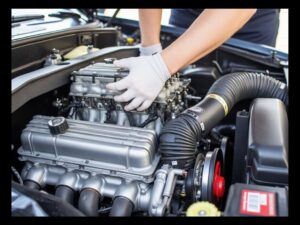A Diesel Particulate Filter, commonly known as DPF, is an essential component in modern diesel engines designed to trap and reduce soot or particulate matter from the exhaust gases. This system plays a critical role in reducing air pollution, making diesel vehicles more environmentally friendly.

Why Does Your DPF Need Cleaning or Regeneration?
Over time, the DPF can become clogged with soot, which not only reduces engine performance but also increases fuel consumption. Cleaning or regenerating the DPF involves burning off this accumulated soot to restore the filter’s efficiency.
How to Perform a DPF Regeneration
Understanding Regeneration
Regeneration can be either passive or active. Passive regeneration happens automatically when driving at higher speeds or loads, where the exhaust temperature is sufficient to burn off soot. Active regeneration, on the other hand, might require you to initiate it manually or through the vehicle’s computer system.
Manual DPF Regeneration Steps
- Check Vehicle Conditions: Ensure your vehicle has at least a quarter tank of fuel, the engine is warm, and there are no fault codes stored in the system.
- Drive for Regeneration: If your vehicle allows, drive at a constant speed of around 65 mph for about 20-30 minutes. This often triggers a regeneration process.
- Using a Diagnostic Tool: For a more controlled regeneration, especially if driving doesn’t solve the issue, you might need a diagnostic tool. Connect it to your vehicle’s OBD-II port, and follow the manufacturer’s instructions to initiate a regeneration cycle. This tool communicates with the engine control unit (ECU) to start the process.
- Stationary Regeneration: Some vehicles allow for regeneration while parked. Ensure the vehicle is in park, the parking brake is engaged, and follow the vehicle’s manual or diagnostic tool instructions for a parked regeneration.
Signs Your DPF Needs Regeneration
- DPF Warning Light: If this light comes on, it’s a direct indication that regeneration is needed or in progress.
- Decreased Performance: If your vehicle feels less powerful or fuel efficiency drops, it might be time for regeneration.
Cleaning the DPF Filter
If regeneration doesn’t suffice, or for deeper cleaning:
- Professional Cleaning: Some services offer high-pressure cleaning or chemical cleaning of the DPF. This method can be more thorough but should be done by professionals to avoid damaging the filter.
- DIY Cleaning: While not recommended for regular maintenance due to potential damage, if you must, use water-based cleaners and scrub gently. Avoid harsh chemicals or high-pressure washers directly on the filter.
Tips to Avoid DPF Problems
- Regular Long Drives: Try to include long highway drives in your routine to promote passive regeneration.
- Quality Fuel and Oil: Using high-quality diesel and engine oil can reduce soot accumulation.
- Avoid Short Trips: Frequent short drives can lead to incomplete regeneration. If possible, combine trips.
What Happens During DPF Regeneration?
During regeneration, the engine might inject extra fuel to increase exhaust temperature, which burns off the soot. This process might be noticeable by a slight increase in engine noise or a temporary increase in fuel consumption.
Maintaining your DPF through regular regeneration or cleaning not only keeps your vehicle running efficiently but also helps in reducing environmental impact. Whether through driving habits or using diagnostic tools, understanding how to manage your DPF can save you from costly repairs and ensure your diesel engine remains a reliable choice for years. Remember, if in doubt, consulting with a professional mechanic or using certified cleaning services might be the safest route.
